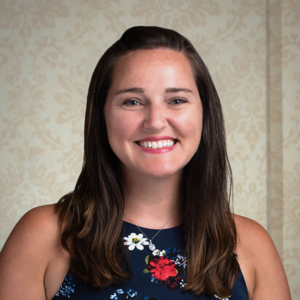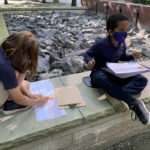We welcome Diploma Programme (DP) graduate and IB educator Sarah Clancy, of the International Academy, to reflect on how service learning is integrated in the Middle Years Programme (MYP) and the DP. This is her first story in the graduate voices series.

“I marvel at the teaching and learning opportunities available to students and teachers through my experience in the MYP and DP continuum”
Although I spent years teaching Middle Years Programme (MYP) and Diploma Programme (DP) literature courses, I kept a fairly narrow view of the IB continuum. This, in large, was because I had plenty to keep myself busy: creating engaging, level-appropriate learning activities, offering formative opportunities for growth, grading summative assessments, giving feedback on practice IB exams and caring for the well-being of my 150+ students on a daily basis. It was not until I stepped out of the classroom into a leadership role in our 9-12 full-IB diploma school that I came to a better understanding of the continuum and all the ways in which the core elements of the programmes scaffold to form an IB student. With this full picture, I marvel at the teaching and learning opportunities available to students and teachers through my experience in the MYP and DP continuum.
I’m going to use my three columns as an alum-educator blogger to highlight the ways in which the MYP personal project, DP extended essay and DP creativity, activity, service (CAS) component of the core meet the IB’s mission of developing creative, critical and caring thinkers. I wrote the first draft of this story before the COVID-19 crisis became a part of our daily lives, but I am continuing to ask students to think about these projects in new ways as they work remotely. So, I hope you will consider these ideas to support learning whether students are in the classroom or at home by tying assignments and activities more closely with students’ interests and determining the feasibility activities which might not have been possible in the classroom but are perfect for this time and place context.
Rolling out tonight... spring break CAS: Choose your own adventure! 🌴☀️🧡 @iborganization. The next day’s opportunities will be posted at 8pm the night before. Stay tuned! https://t.co/DeYf5j5jBg pic.twitter.com/CPMmBnc7QK
— Sarah Clancy (@MsClancy09) April 5, 2020
First up: the personal project, which occurs in year 5 of the MYP. You can read more about the personal project in the Projects Guide here.
We have almost 400 students completing their personal project each year. As you might expect, the range of complexity, engagement and intellectual challenge is wide. Students who find a true personal interest to explore fully and with enthusiasm tend to be more on-task during the project’s planning, implementation and reflection. But how can we help a student consider what matters to them and/or their community and develop a project that motivates them to work independently, use skills gained from learning and can be expressed in the form of a creative or practical outcome?
I have a few ideas.
1. Plan a personal inventory.
At the beginning of the school year, I invited students to complete a personal inventory which asked the following questions:
- Interests: I like to learn and think about ….
- Skills and talents: I can ….
- Areas for growth: What I aim to develop or improve …
- Being helpful: Describe a time when you helped someone:
- Receiving help: Describe a time when someone helped you:
With a personal inventory, we demonstrate to students that we value their inquiry time and want them to think about what they’d like to learn, especially what they enjoy, areas for growth and ways in which they can help by thinking about all of the above. I include the final bullet for students to consider how to pay forward what someone else has taught or done for them. It says to students implicitly, “we care about you as a person and the personal project is a way for you to showcase what makes you, “you”. In the book, The Path to Purpose by William Damon, he advocates for the pursuit of purpose to, “directly engage young people in life experiences likely to enhance their optimism and self-confidence”. If we start this process of building up from what they do well, what interests them and how they could (continue to) contribute to their community, we support their capabilities as well as challenge them to explore.
Note: We do talk about the difference between skills and talents; I use myself as an example when I talk about making small talk: I can do it, but I really have to work at it, so it is more of a skill I’ve developed over time than a natural ability (talent).
2. Connect service as action.
In her book The Complete Guide to Service Learning, Cathy Berger Kaye wrote, “service learning connects school-based learning with the inherent caring and concern young people have for their world.” By intentionally creating space for the connections between content, interests and this inherent care and concern, students see that we value service to their community in the form of action, advocacy and research. While learning skills through the process of personal project, students also see their role as responsible global citizens. There is no requirement for the personal project to contribute meaningfully to the student’s community. However, in our school we’ve encouraged thinking in this direction for two reasons. Firstly, it places their project more firmly in a global context and enriches their inquiry into a particular topic, issue or problem. Secondly, it simply aligns more strongly with the IB’s mission of developing young people that help create a better and more peaceful world. Through their experience as MYP students, service as action connects their knowledge and understanding in content areas. Personal projects can enhance their understanding of responsible action and empower them to use their interests, skills and knowledge for service.
3. Contextualize their personal project.
The DP’s extended essay and CAS are natural extensions of student learning from the personal project. The ways in which the personal project informs topic or experience selection, promotes research, thinking and self-management skills, invites risk-taking and engages personal interests speaks to its importance not only in the development of lifelong learners but also in the firm foundation DP requires for its core. But even if you’re not in a continuum school, connecting student service learning to the college essay they might eventually write, will help them see its usefulness beyond the, “because I have to,” mentality schoolwork brings. Instead, students come to the realization, with the help of supervisors and mentors, that the experiences they devote time and energy to ultimately brings about a joy of learning and transformation.

Sarah Clancy graduated from International Academy in Bloomfield Hills, Michigan, U.S. She studied English and German at Kalamazoo College and holds an MEd in teaching and an MS in restorative practices. Sarah has taught at her alma mater since 2009, where she taught MYP and DP literature and currently coordinates service learning and CAS. She’s a reader of fiction, yoga practitioner and happiest on a beach.
Visit our dedicated page to read how the IB is addressing the Coronavirus (COVID-19) outbreak, including developing news and actions that are being taken to support and protect our community.
If you enjoyed this story, consider reading more below:



